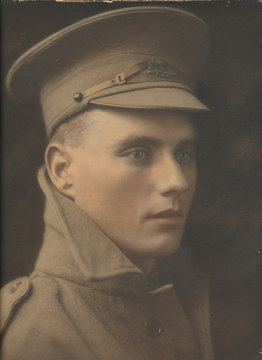BRENNAN, John Francis
| Service Number: | 63941 |
|---|---|
| Enlisted: | Not yet discovered |
| Last Rank: | Private |
| Last Unit: | Army Medical Corps (AIF) |
| Born: | Adelaide, South Australia, 19 January 1893 |
| Home Town: | Not yet discovered |
| Schooling: | Not yet discovered |
| Occupation: | Bank Clerk |
| Died: | South Australia, 31 January 1956, aged 63 years, cause of death not yet discovered |
| Cemetery: |
Centennial Park Cemetery, South Australia RC A Path AS 259A |
| Memorials: |
World War 1 Service
| 5 Jun 1918: | Involvement Private, 63941, Army Medical Corps (AIF), --- :embarkation_roll: roll_number: '23' embarkation_place: Sydney embarkation_ship: RMS Orontes embarkation_ship_number: '' public_note: '' | |
|---|---|---|
| 5 Jun 1918: | Embarked Private, 63941, Army Medical Corps (AIF), RMS Orontes, Sydney |
Help us honour John Francis Brennan's service by contributing information, stories, and images so that they can be preserved for future generations.
Add my storyBiography contributed by tony griffin
John Francis Brennan was the son of William Charles Brennan, the Postmaster at Port Lincoln, South Australia. A bank clerk, John was 24 years 7 months old when he enlisted in Adelaide on 28th August, 1917.
John was initially appointed to B Company, Mitcham Army Camp and a short time later, on the 12th September transferred to the Australian Army Medical Corps. After 4 months of training John was posted to Reinforcements in preparation for overseas service. On the 5th June he embarked from Sydney aboard the troopship RMS “Orontes” and disembarked in Liverpool, England on the 11th August 1918. On the 12th August John marched into the Australian Army Medical Corp Training Hospital at Fovant but on the 20th September was remustered as a gunner and taken on strength with the Artillery Details at Heytesbury Artillery Camp.
John was admitted to hospital with the measles on 11th November, 1918. For John there would be no future fighting as this was the same day that the armistice was signed, ending World War 1. He was discharged from hospital on the 18th November and 9 days later proceeded to join the British Expeditionary Force at Heytesbury ready to cross the English Channel to France. On landing he marched out to the 5th Divisional Artillery at Roulles and a week later was taken on strength with the 55th Field Artillery Battery.
During this time of heavy snow and very cold conditions the units of the 5th Divisional Artillery were preparing for demobilisation. Those men that had served in France were gradually repatriated back to England for return to Australia. Those that remained, like John, prepared equipment to be returned to Ordnance. All harness and saddlery had to be stripped, disinfected and heavily dubbed. All guns had to have sights, aiming posts, breech and muzzle covers removed and packed and also had to be heavily greased. All the animals had to be tended and prepared for sale.
With the demobilisation of the 5th Divisional Artillery complete, John was attached to the 15th Field Artillery Brigade on the 14th April 1919, before marching out for his return to Australia. He returned to England on the 22nd May and the following day marched into camp at Weymouth. John embarked aboard the troopship “Friedrichsruh” on the 8th July and disembarked in Australia on the 29th August, 1919. He was discharged in Adelaide on the 13th September 1919.
John married Rose “Dollie” Griffin in St. Dominic’s Church, Hammond on 25 January 1922. He died on 31 January 1956. John and Dollie are buried together in Centennial Park Cemetery, RC A Path As 259A.









